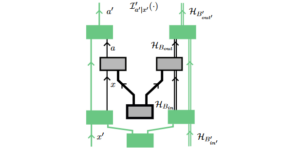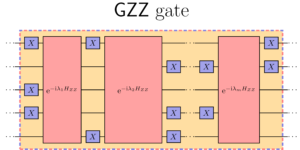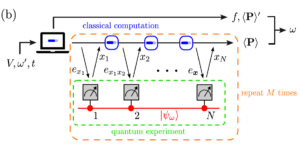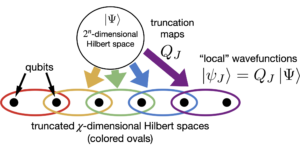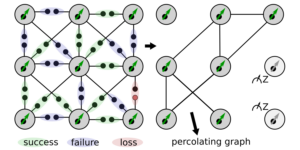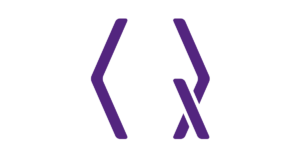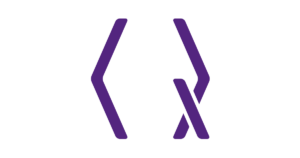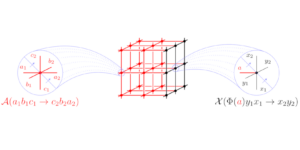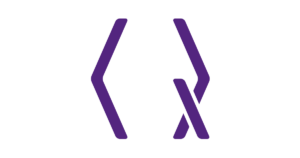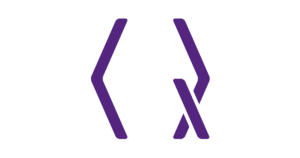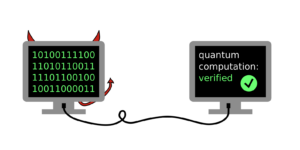1Quantum Technology Lab, Dipartimento di Fisica Aldo Pontremoli, Università degli Studi di Milano, I-20133 Milano, Italy
2Vienna Center for Quantum Science and Technology (VCQ), Faculty of Physics, University of Vienna, Boltzmanngasse 5, A-1090 Vienna, Austria
3Institute of Quantum Optics and Quantum Information (IQOQI), Austrian Academy of Sciences, Boltzmanngasse 3, A-1090 Vienna, Austria
4Perimeter Institute for Theoretical Physics, 31 Caroline St. N, Waterloo, Ontario, N2L 2Y5, Canada
5Quantum Technology Lab, Dipartimento di Fisica Aldo Pontremoli, Università degli Studi di Milano, I-20133 Milano, Italy
6INFN, Sezione di Milano, I-20133 Milano, Italy
Find this paper interesting or want to discuss? Scite or leave a comment on SciRate.
Abstract
Atomic clock interferometers are a valuable tool to test the interface between quantum theory and gravity, in particular via the measurement of gravitational time dilation in the quantum regime. Here, we investigate whether gravitational time dilation may be also used as a resource in quantum information theory. In particular, we show that for a freely falling interferometer and for a Mach-Zehnder interferometer, the gravitational time dilation may enhance the precision in estimating the gravitational acceleration for long interferometric times. To this aim, the interferometric measurements should be performed on both the path and the clock degrees of freedom.
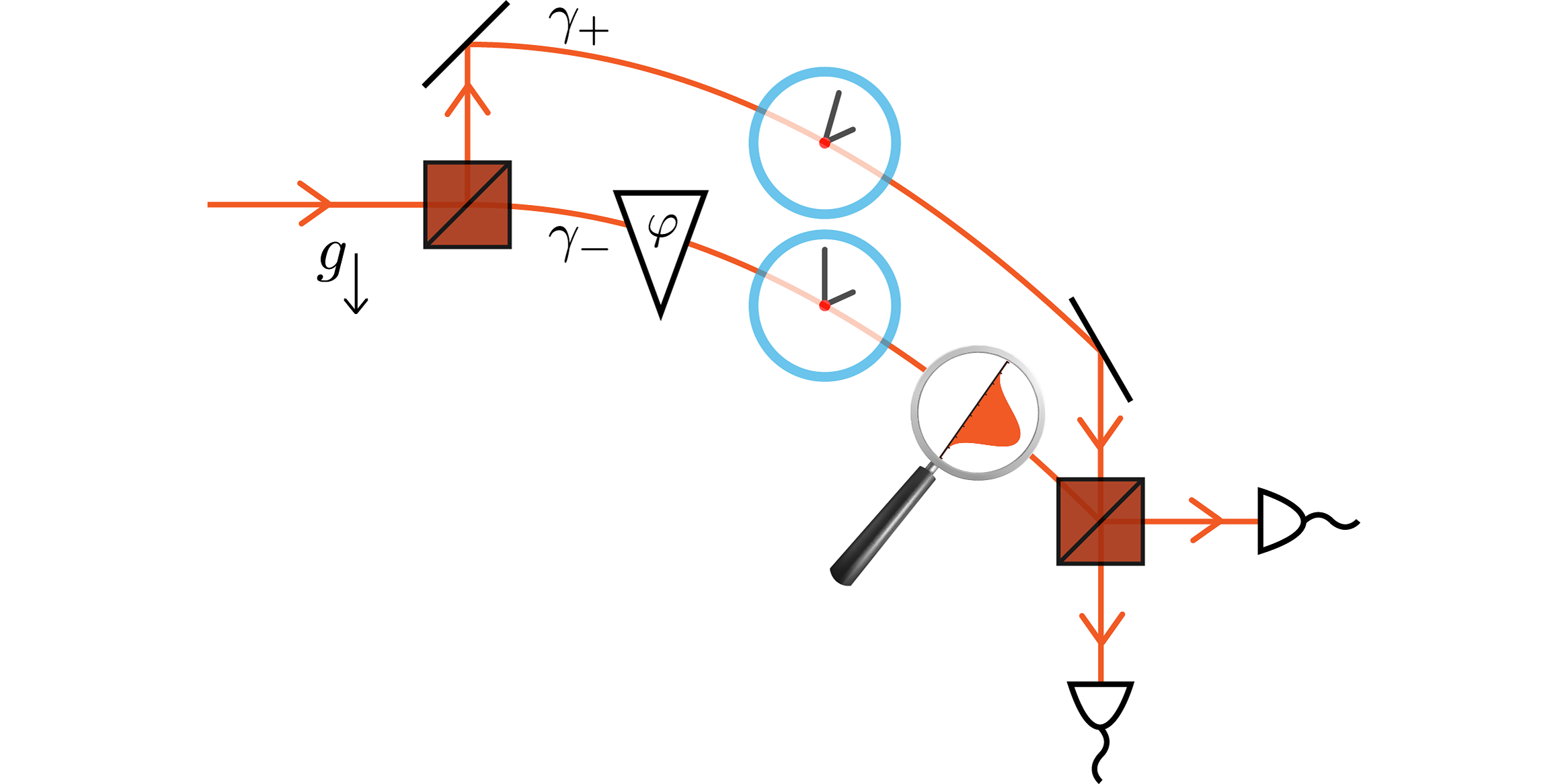
Featured image: An atomic clock interferometer uses gravitational time dilation to improve measurement of the gravitational acceleration
Popular summary
► BibTeX data
► References
[1] Juan Yin, Yu-Huai Li, Sheng-Kai Liao, Meng Yang, Yuan Cao, Liang Zhang, Ji-Gang Ren, Wen-Qi Cai, Wei-Yue Liu, Shuang-Lin Li, Rong Shu, Yong-Mei Huang, Lei Deng, Li Li, Qiang Zhang, Nai-Le Liu, Yu-Ao Chen, Chao-Yang Lu, Xiang-Bin Wang, Feihu Xu, Jian-Yu Wang, Cheng-Zhi Peng, Artur K. Ekert, and Jian-Wei Pan. “Entanglement-based secure quantum cryptography over 1,120 kilometres”. Nature 582, 501–505 (2020).
https://doi.org/10.1038/s41586-020-2401-y
[2] Dmitry Green, Henning Soller, Yuval Oreg, and Victor Galitski. “How to profit from quantum technology without building quantum computers”. Nature Rev. Phys. 3, 150–152 (2021).
https://doi.org/10.1038/s42254-021-00290-w
[3] Samuel L. Braunstein and Carlton M. Caves. “Statistical distance and the geometry of quantum states”. Phys. Rev. Lett. 72, 3439–3443 (1994).
https://doi.org/10.1103/PhysRevLett.72.3439
[4] Matteo G. A. Paris. “Quantum estimation for quantum technology”. International Journal of Quantum Information 07, 125–137 (2009).
https://doi.org/10.1142/S0219749909004839
[5] Vittorio Giovannetti, Seth Lloyd, and Lorenzo Maccone. “Advances in quantum metrology”. Nature Photonics 5, 222–229 (2011).
https://doi.org/10.1038/nphoton.2011.35
[6] J.-F. Pascual-Sánchez. “Introducing relativity in global navigation satellite systems”. Ann. Phys. (Leipzig) 16, 258–273 (2007).
https://doi.org/10.1002/andp.200610229
[7] Daniel M. Greenberger. “Theory of particles with variable mass. I. formalism”. Journal of Mathematical Physics 11, 2329–2340 (1970).
https://doi.org/10.1063/1.1665400
[8] Claus Lämmerzahl. “Quantum tests of the foundations of general relativity”. Classical and Quantum Gravity 15, 13–27 (1998).
https://doi.org/10.1088/0264-9381/15/1/003
[9] Holger Müller, Achim Peters, and Steven Chu. “A precision measurement of the gravitational redshift by the interference of matter waves”. Nature 463, 926–929 (2010).
https://doi.org/10.1038/nature08776
[10] M Zych, I Pikovski, F Costa, and Č Brukner. “General relativistic effects in quantum interference of “clocks””. Journal of Physics: Conference Series 723, 012044 (2016).
https://doi.org/10.1088/1742-6596/723/1/012044
[11] Igor Pikovski, Magdalena Zych, Fabio Costa, and Časlav Brukner. “Time dilation in quantum systems and decoherence”. New J. Phys. 19, 025011 (2017).
https://doi.org/10.1088/1367-2630/aa5d92
[12] Victoria Xu, Matt Jaffe, Cristian D. Panda, Sofus L. Kristensen, Logan W. Clark, and Holger Müller. “Probing gravity by holding atoms for 20 seconds”. Science 366, 745–749 (2019).
https://doi.org/10.1126/science.aay6428
[13] Albert Roura. “Gravitational redshift in quantum-clock interferometry”. Phys. Rev. X 10, 021014 (2020).
https://doi.org/10.1103/PhysRevX.10.021014
[14] Albert Roura, Christian Schubert, Dennis Schlippert, and Ernst M. Rasel. “Measuring gravitational time dilation with delocalized quantum superpositions”. Phys. Rev. D 104, 084001 (2021).
https://doi.org/10.1103/PhysRevD.104.084001
[15] Fabio Di Pumpo, Christian Ufrecht, Alexander Friedrich, Enno Giese, Wolfgang P. Schleich, and William G. Unruh. “Gravitational redshift tests with atomic clocks and atom interferometers”. PRX Quantum 2, 040333 (2021).
https://doi.org/10.1103/PRXQuantum.2.040333
[16] Magdalena Zych, Fabio Costa, Igor Pikovski, and Časlav Brukner. “Quantum interferometric visibility as a witness of general relativistic proper time”. Nat. Commun. 2, 505 (2011).
https://doi.org/10.1038/ncomms1498
[17] Igor Pikovski, Magdalena Zych, Fabio Costa, and Časlav Brukner. “Universal decoherence due to gravitational time dilation”. Nature Physics 11, 668–672 (2015).
https://doi.org/10.1038/nphys3366
[18] H. Salecker and E. P. Wigner. “Quantum limitations of the measurement of space-time distances”. Phys. Rev. 109, 571–577 (1958).
https://doi.org/10.1103/PhysRev.109.571
[19] Esteban Castro-Ruiz, Flaminia Giacomini, Alessio Belenchia, and Časlav Brukner. “Quantum clocks and the temporal localisability of events in the presence of gravitating quantum systems”. Nature Communications 11, 2672 (2020).
https://doi.org/10.1038/s41467-020-16013-1
[20] Kiran E. Khosla and Natacha Altamirano. “Detecting gravitational decoherence with clocks: Limits on temporal resolution from a classical-channel model of gravity”. Phys. Rev. A 95, 052116 (2017).
https://doi.org/10.1103/PhysRevA.95.052116
[21] Magdalena Zych, Fabio Costa, Igor Pikovski, and Časlav Brukner. “Bell’s theorem for temporal order”. Nat. Commun. 10, 1–10 (2019).
https://doi.org/10.1038/s41467-019-11579-x
[22] Esteban Castro-Ruiz, Flaminia Giacomini, Alessio Belenchia, and Časlav Brukner. “Quantum clocks and the temporal localisability of events in the presence of gravitating quantum systems”. Nat. Commun. 11, 1–12 (2020).
https://doi.org/10.1038/s41467-020-16013-1
[23] Shishir Khandelwal, Maximilian P.E. Lock, and Mischa P. Woods. “Universal quantum modifications to general relativistic time dilation in delocalised clocks”. Quantum 4, 309 (2020).
https://doi.org/10.22331/q-2020-08-14-309
[24] Alexander R. H. Smith and Mehdi Ahmadi. “Quantum clocks observe classical and quantum time dilation”. Nat. Commun. 11, 1–9 (2020).
https://doi.org/10.1038/s41467-020-18264-4
[25] Piotr T. Grochowski, Alexander R. H. Smith, Andrzej Dragan, and Kacper Dębski. “Quantum time dilation in atomic spectra”. Phys. Rev. Research 3, 023053 (2021).
https://doi.org/10.1103/PhysRevResearch.3.023053
[26] Flaminia Giacomini. “Spacetime Quantum Reference Frames and superpositions of proper times”. Quantum 5, 508 (2021).
https://doi.org/10.22331/q-2021-07-22-508
[27] Germain Tobar, Simon Haine, Fabio Costa, and Magdalena Zych. “Mass-energy equivalence in gravitationally bound quantum states of the neutron” (2022). arXiv:2112.03303.
arXiv:2112.03303
[28] Luigi Seveso and Matteo G.A. Paris. “Can quantum probes satisfy the weak equivalence principle?”. Annals of Physics 380, 213–223 (2017).
https://doi.org/10.1016/j.aop.2017.03.021
[29] Luigi Seveso, Valerio Peri, and Matteo G. A. Paris. “Does universality of free-fall apply to the motion of quantum probes?”. Journal of Physics: CS 880, 012067 (2017).
https://doi.org/10.1088/1742-6596/880/1/012067
[30] Magdalena Zych and Časlav Brukner. “Quantum formulation of the einstein equivalence principle”. Nature Physics 14, 1027–1031 (2018).
https://doi.org/10.1038/s41567-018-0197-6
[31] Carlo Cepollaro and Flaminia Giacomini. “Quantum generalisation of Einstein’s equivalence principle can be verified with entangled clocks as quantum reference frames” (2021). arXiv:2112.03303.
arXiv:2112.03303
[32] Mehdi Ahmadi, David Edward Bruschi, and Ivette Fuentes. “Quantum metrology for relativistic quantum fields”. Phys. Rev. D 89, 065028 (2014).
https://doi.org/10.1103/PhysRevD.89.065028
[33] Yao Yao, Xing Xiao, Li Ge, Xiao-guang Wang, and Chang-pu Sun. “Quantum fisher information in noninertial frames”. Phys. Rev. A 89, 042336 (2014).
https://doi.org/10.1103/PhysRevA.89.042336
[34] Mehdi Ahmadi, David Edward Bruschi, Carlos Sabín, Gerardo Adesso, and Ivette Fuentes. “Relativistic quantum metrology: Exploiting relativity to improve quantum measurement technologies”. Scientific Reports 4, 4996 (2014).
https://doi.org/10.1038/srep04996
[35] Dominic Hosler and Pieter Kok. “Parameter estimation using NOON states over a relativistic quantum channel”. Phys. Rev. A 88, 052112 (2013).
https://doi.org/10.1103/PhysRevA.88.052112
[36] Mariona Aspachs, Gerardo Adesso, and Ivette Fuentes. “Optimal quantum estimation of the Unruh-Hawking effect”. Phys. Rev. Lett. 105, 151301 (2010).
https://doi.org/10.1103/PhysRevLett.105.151301
[37] Jieci Wang, Zehua Tian, Jiliang Jing, and Heng Fan. “Quantum metrology and estimation of Unruh effect”. Scientific Reports 4, 7195 (2014).
https://doi.org/10.1038/srep07195
[38] Magdalena Zych, Łukasz Rudnicki, and Igor Pikovski. “Gravitational mass of composite systems”. Phys. Rev. D 99, 104029 (2019).
https://doi.org/10.1103/PhysRevD.99.104029
[39] Andrew D. Ludlow, Martin M. Boyd, Jun Ye, E. Peik, and P. O. Schmidt. “Optical atomic clocks”. Rev. Mod. Phys. 87, 637–701 (2015).
https://doi.org/10.1103/RevModPhys.87.637
[40] Michail Kritsotakis, Stuart S. Szigeti, Jacob A. Dunningham, and Simon A. Haine. “Optimal matter-wave gravimetry”. Phys. Rev. A 98, 023629 (2018).
https://doi.org/10.1103/PhysRevA.98.023629
[41] Daniel Carney, Thomas Cecil, John Ellis, R. F. Garcia Ruiz, Andrew A. Geraci, David Hanneke, Jason Hogan, Nicholas R. Hutzler, Andrew Jayich, Shimon Kolkowitz, Gavin W. Morley, Holger Muller, Zachary Pagel, Christian Panda, and Marianna S. Safronova. “Snowmass 2021: Quantum sensors for hep science – interferometers, mechanics, traps, and clocks” (2022). arXiv:2203.07250.
arXiv:2203.07250
[42] Jing Liu, Haidong Yuan, Xiao-Ming Lu, and Xiaoguang Wang. “Quantum fisher information matrix and multiparameter estimation”. Journal of Physics A: Mathematical and Theoretical 53, 023001 (2019).
https://doi.org/10.1088/1751-8121/ab5d4d
[43] F. Albarelli, M. Barbieri, M.G. Genoni, and I. Gianani. “A perspective on multiparameter quantum metrology: From theoretical tools to applications in quantum imaging”. Physics Letters A 384, 126311 (2020).
https://doi.org/10.1016/j.physleta.2020.126311
[44] J. J. Sakurai and Jim Napolitano. “Modern quantum mechanics”. Cambridge University Press. (2020). 3 edition.
https://doi.org/10.1017/9781108587280
[45] Luigi Seveso, Valerio Peri, and Matteo G A Paris. “Quantum limits to mass sensing in a gravitational field”. Journal of Physics A: Mathematical and Theoretical 50, 235301 (2017).
https://doi.org/10.1088/1751-8121/aa6cc5
Cited by
[1] Germain Tobar, Simon Haine, Fabio Costa, and Magdalena Zych, “Mass-energy equivalence in gravitationally bound quantum states of the neutron”, Physical Review A 106 5, 052801 (2022).
The above citations are from SAO/NASA ADS (last updated successfully 2023-03-14 13:09:08). The list may be incomplete as not all publishers provide suitable and complete citation data.
On Crossref’s cited-by service no data on citing works was found (last attempt 2023-03-14 13:09:03).
This Paper is published in Quantum under the Creative Commons Attribution 4.0 International (CC BY 4.0) license. Copyright remains with the original copyright holders such as the authors or their institutions.
- SEO Powered Content & PR Distribution. Get Amplified Today.
- Platoblockchain. Web3 Metaverse Intelligence. Knowledge Amplified. Access Here.
- Source: https://quantum-journal.org/papers/q-2023-03-13-946/
- :is
- ][p
- 1
- 10
- 11
- 1994
- 1998
- 2011
- 2014
- 2016
- 2017
- 2018
- 2019
- 2020
- 2021
- 2022
- 28
- 39
- 7
- 8
- 9
- 98
- a
- above
- ABSTRACT
- Academy
- access
- accuracy
- advancements
- affiliations
- Alexander
- All
- and
- Andrew
- applications
- Apply
- ARE
- AS
- atom
- austrian
- author
- authors
- BE
- between
- Bound
- Break
- Building
- by
- cambridge
- CAN
- Center
- Channel
- Chao-Yang Lu
- chen
- Claus
- Clock
- Clocks
- combined
- comment
- Commons
- Communications
- complete
- computers
- Conference
- constant
- copyright
- cryptography
- Daniel
- data
- David
- discuss
- distance
- e
- edition
- Edward
- effect
- effects
- events
- Exploring
- Falling
- fan
- field
- Fields
- For
- found
- Foundations
- Freedom
- from
- ge
- General
- Global
- gps
- gravitational
- gravity
- Green
- harvard
- Have
- here
- holders
- holding
- How
- HTTPS
- i
- idea
- image
- Imaging
- improve
- in
- information
- Institute
- institutions
- interesting
- Interface
- Interference
- International
- investigate
- investigates
- ITS
- JavaScript
- Jian-Wei Pan
- Jim
- John
- journal
- lab
- Last
- Leave
- Led
- Li
- License
- limitations
- limits
- List
- Logan
- Long
- many
- Martin
- Mass
- mathematical
- Matrix
- Matter
- max-width
- measurements
- measuring
- mechanics
- Metrology
- MILANO
- model
- Modifications
- Month
- motion
- Nature
- Navigation
- New
- observe
- of
- on
- Ontario
- open
- optics
- order
- original
- Paper
- paris
- particular
- path
- perspective
- phenomenon
- physical
- Physics
- plato
- Plato Data Intelligence
- PlatoData
- Precision
- presence
- press
- principle
- Profit
- proper
- provide
- published
- publisher
- publishers
- Quantum
- quantum computers
- quantum cryptography
- quantum information
- quantum measurement
- Quantum Mechanics
- Quantum optics
- Quantum sensors
- quantum systems
- quantum technology
- recent
- references
- regime
- remains
- ren
- Reports
- research
- Resolution
- resource
- review
- revolutionized
- s
- satellite
- Science
- Science and Technology
- SCIENCES
- scientific
- seconds
- secure
- sensors
- Series
- Shimon
- should
- show
- Simon
- States
- Successfully
- such
- suitable
- Sun
- Systems
- technological
- Technologies
- Technology
- test
- tests
- that
- The
- their
- theoretical
- These
- time
- times
- Title
- to
- tool
- tools
- traps
- under
- understand
- university
- updated
- URL
- Valuable
- verified
- via
- Victoria
- visibility
- volume
- W
- waves
- Way..
- whether
- with
- without
- witness
- Woods
- works
- world
- X
- Ye
- year
- years
- Yuan
- zephyrnet


